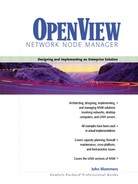Managed vs. Unmanaged Devices
NNM subjects a managed object to routine polling for status and configuration, and the snmpCollect daemon will collect SNMP data from the managed device. The managed object’s icon will reflect its status. An unmanaged device is not polled and no SNMP data is collected for it. Its status isn’t known so the icon will not affect the status of its container. The unmanaged object’s icon color is wheat.
Network managers frequently unmanage devices or interfaces for various reasons:
they fall outside the management domain and it’s too difficult, bothersome, or inconvenient to prevent them from being discovered otherwise
the device is being serviced and therefore the map should be green
the device is experimental, it passes the discovery filter, but it’s not part of the mission critical network so you don’t want to monitor it
NNM polling is negatively impacting the managed device and its administrator has politely requested or vehemently demanded that it not be managed anymore
the interface is always down because it’s a backup link used for fail-over purposes
this is an extra interface that’s configured but not used at all
The terms object and device are purposely used loosely in the preceding discussion. That’s because some objects represent actual devices, others represent interfaces and connections, and there are also abstract object containers such as subnets and segments. Therefore, if the network manager selects a router icon and chooses Edit:Unmanage from the menu, the router and all its contained interfaces become unmanaged. A router is a real device, as are its interfaces. A single interface can be unmanaged by opening the router icon, selecting the interface, and choosing Edit:Unmanage from the menu. But an abstract container icon such as a segment can also be unmanaged, which means all the devices within it become unmanaged.
If you look at a map and see that a device is unmanaged, is that device really unmanaged? In cases where this device belongs in several maps, only if is unmanaged in every map is it truly unmanaged. If just one map contains a managed version of the device, then netmon will poll it. Check the actual management status of the device using the ovtopodump -L device_name command.
Note that if a device is unmanaged in the management domain of a collection station, and if that device is exported to a management station, then the unmanaged status is also exported. Suppose two or more collection stations either manage or unmanage the device. It can be troublesome if multiple collection stations contain this device because one of them is the designated primary for it, but which one? There are nine rules the management station uses for selecting the primary collection station for an object. The answer to our question is found in rules 3, 5, and 9:
rule 3: If only one of many possible collection stations reporting the object is managed and has non-critical status, then that station has primary ownership of the object.
rule 5: If only one collection station has the object in a managed state (either via default or intentional selection), that station is designated as primary for that object.
rule 9: The first collection station to report the object is deemed primary by the management station. Ownership of the object is not restricted to that collection station in the event that collection station ceases to monitor the object.
See Chapter 5 of the HP OpenView Advanced Network Node Manager Student Workbook for a comprehensive treatment of these rules.
Note that an unmanaged device may still send SNMP traps to the collection station if its SNMP agent has the NNM management system listed in its trap forwarding table. The NNM menus will generally operate on an unmanaged device.
